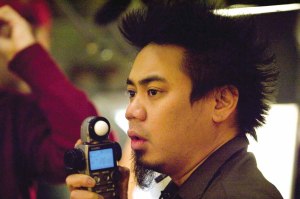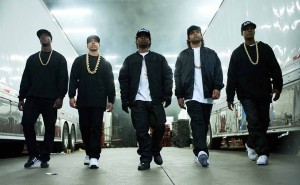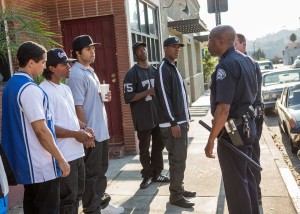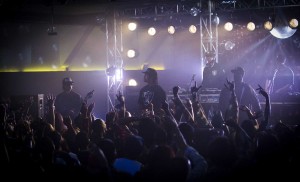
Directed by F. Gary Gray, Straight Outta Compton is a coming-of-age story of the now infamous rap group N.W.A. (Niggaz Wit Attitudes) as they emerge from the streets of Compton in Los Angeles, Calif. The founding members included Dre, Ice Cube, Eazy-E, DJ Yella and MC Ren. When the director and cinematographer met to discuss the story, Libatique had ideas about camera movement, but little on imagery. “If you try to research that time period there isn’t much out there if anything. Reference wise there wasn’t any fine art or fashion photography of these guys. The images were basically snapshots of friends who were in the room or around N.W.A. at the time. It was pre-social media, pre-cell phone. There wasn’t even Yahoo. It was AOL,” Libatique noted. “What the snapshots did though was put you right there in the time and place where they were.”

To capture the images, the cinematographer looked to the RED Dragon, using Kowa anamorphic lenses. “It was important for us to illustrate how they used to be. We wanted to keep the first acts dirty and gritty. Then give it more shine as they start gaining notoriety and performing in front of larger crowds in the final acts. We ended up shooting with spherical Zeiss Super Speeds, not necessarily for the shiner look, but just to add that next layer,” said Libatique.
It was same for the camera movements. Handheld work eventually gave way to Steadicam and Spydercam shots, for the group’s later performances. “When Ice Cube and Dre perform at Dodo’s for the first time, we kept everything very minimal and naturalistic with our camera movements and lighting. There wasn’t even any key lights for Cube at Dodo’s. I wanted him to look more menacing and harder because that’s what his persona always was,” explained Libatique. “When they start to go on tour and get bigger, so did the lighting and we introduced more sophisticated camera movements. We wanted to use those concerts as a through line and jumping off point to show their success.”
 But the imagery wasn’t all framed by handheld work. “Gary’s whole thing was that he wanted the audience to connect with these guys as characters not as rappers. He wanted to the audience to feel the emotion and the drama of the story,” Libatique said. “My job was to come in and not splash his vision with too much style. He would call me out on anything that felt unreal to that time and place.” To shape the emotion and energy to scenes, the cinematography looked to choreograph camera movements to capture sequences in one fluid take instead of several edits.
But the imagery wasn’t all framed by handheld work. “Gary’s whole thing was that he wanted the audience to connect with these guys as characters not as rappers. He wanted to the audience to feel the emotion and the drama of the story,” Libatique said. “My job was to come in and not splash his vision with too much style. He would call me out on anything that felt unreal to that time and place.” To shape the emotion and energy to scenes, the cinematography looked to choreograph camera movements to capture sequences in one fluid take instead of several edits.
One of those moments happens in a hotel while N.W.A is on the road. The sequence starts with Dre on the phone and he hears a knock on the door revealing a guy and his friends with a gun looking for his girlfriend, Felicia. Dre ends up closing the door and walking over to the adjoining door of the room where there’s a huge party going on. Dre moves through the crowd looking for her. The camera then picks up another girl at the party who goes into the bathroom, revealing Felicia hooking up with Eazy-E. But then the camera picks up Eazy-E leaving the bathroom where he tosses guns to other members of N.W.A., who poke their heads out of their hotel door to see the guys waiting for Felicia. The group then chases the intruders down the hallway. The scene was all choreographed using the MoVi. “We were trying to find ways for the action to lead into other action instead of something being cutty. We tried to do it in the choreography as much as we could to show the culture. As much as people know N.W.A., and as much as that subculture has entered into the lexicon of who we are as a pop culture, I feel like the camera could get you into the culture as a reality. Layering all those things hopefully builds to a language,” explained Libatique.
 Throughout the arc of production the director and cinematographer wanted to be specific with their coverage, but it wasn’t until they got into the physical space of the location that they defined what type of coverage they could get. “Gary, like most great directors, wants to rehearse as many times as they need to find the emotion to the scene and to see where the character is going to physically end up – if it’s Dre at the mixing board or Eazy-E wandering the room. Gary was really searching for the tone, attitude and authenticity in scenes. And as you watch, you start to do the math of what’s possible and move the camera based on what they are doing.” From a technical standpoint, the anxiety Libatique faced was that the actors mostly wore white tees with black baseball caps and there were almost always multiple characters in a scene. In order to light such circumstances, like in the studio, he used ambient light sources that bled through smoke and a well-placed bounce. “I am not a big fan of key light because it screams film,” said Libatique. “For this project, I didn’t want anyone to know where the light was coming from.”
Throughout the arc of production the director and cinematographer wanted to be specific with their coverage, but it wasn’t until they got into the physical space of the location that they defined what type of coverage they could get. “Gary, like most great directors, wants to rehearse as many times as they need to find the emotion to the scene and to see where the character is going to physically end up – if it’s Dre at the mixing board or Eazy-E wandering the room. Gary was really searching for the tone, attitude and authenticity in scenes. And as you watch, you start to do the math of what’s possible and move the camera based on what they are doing.” From a technical standpoint, the anxiety Libatique faced was that the actors mostly wore white tees with black baseball caps and there were almost always multiple characters in a scene. In order to light such circumstances, like in the studio, he used ambient light sources that bled through smoke and a well-placed bounce. “I am not a big fan of key light because it screams film,” said Libatique. “For this project, I didn’t want anyone to know where the light was coming from.”
The approach was completely different for the film’s climatic scene – a concert in Detroit, where N.W.A. defies police orders and sings one of their hits, “Fuck the Police” without regard. Shots ring out and the group tries to run away before being arrested on site. “We ended up using LED’s even though they weren’t of that time period,” said Libatique. “Jeff Ferrero [gaffer] and Josh Thatcher [dimmer board operator] set everything up and made sure the colors switched in the frame. I can’t thank them enough. Jeff is great. He is always looking for clever ways to do things. We have worked together for so long, he knows the light quality I am looking for and how I like to move the camera around.”
Libatique admits this was a passion project for him as he’s been a fan of hip hop since he was growing up. But one of the more exciting parts to working on this project was the moving camera. “Moving the camera without the connection of the drama and choreography and blocking is one thing, but connecting the choreography and drama to the movement of the camera is a dream. It’s where I really enjoy the challenge. It speaks to being able to create a world where the light isn’t precious. When on a given day you’re moving the shot around 360-degrees multiple times and you’re asking everyone from the focus puller, to the guy pushing the dolly, to guy holding the flag, to the boom guy trying to stay out of the shot – for everyone to come together. You have this team effort you have to plot. I think about those kinds of shots for hours. The energy the camera brings. It was a lot of fun having that on this project.”





